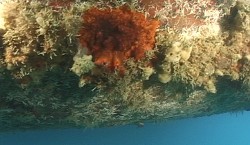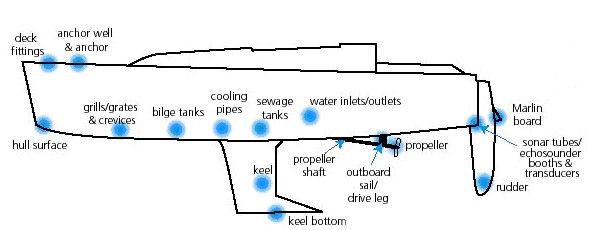
University of California
West Coast Ballast Outreach
Vessel Fouling

Vessel Fouling. Courtesy of Steve Mercer.
their larvae into its waters, possibly establishing themselves in the
new port and spreading to nearby areas.

High risk areas on a recreational vessel, which are similar to those on a commercial vessel. Diagram courtesy of AQIS.
While ballast water is often the primary vector of transer for many species/regions, hull fouling is now recognized as an important AIS vector, introducing more AIS than ballast water in some regions. Hull fouling as a serious problem is not surprising, considering:
- The WSA that arrives into the U.S. annually is equivalent to 2.5 times the area of Washington, D.C. (438 sq km). 1
- 67% percent of this WSA comes from outside the U.S.1
- 70% of the 250 Australia's AIS2 and 74% of Hawaii's AIS3 arrived via biofouling.
- Vessels may contain large amounts biofouling - up to 90 tons.
- Simply cleaning the ship is not enough, as live organisms are often released into the water during this process (image at right).
1 Smithsonian Environmental Research Center
2 Australian Quarantine and Inspection Service. 2005. AQIS Fact Sheet.
3 Godwin, L Scott (2003). Hull Fouling of Maritime Vessels as a Pathway for Marine Species Invasions to the Hawaiian Islands. Biofouling, 19 (1), 0892-7014.